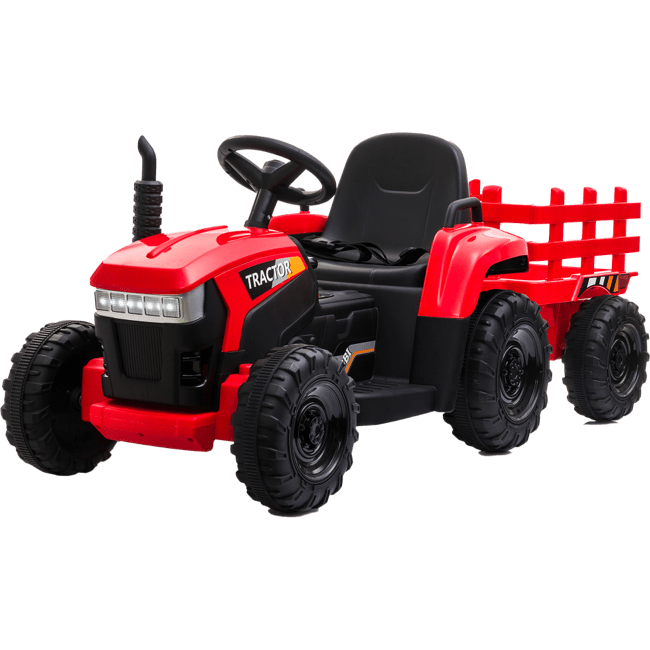- Home
- Shop
- Forest Series
- Grassland Series
- Desert Series
- Contact
- Home
- Shop
- Forest Series
- Grassland Series
- Desert Series
- Contact






REALISTIC DRIVING EXPERIENCE
Press the start button, children can proficiently and independently drive the simulated miniature of a real tractor forward or backward by controlling the spanner and foot pedal. With the 3-gear design (fast/low forward, low backward), kids can adjust the speed to enjoy the realistic fun.
SAFE STRUCTURE WITH 6 WHEELS
Built from strong plastic, the electric toddler tractor can withstand the years of exciting play. Six sturdy wheels (2 are removable) designed with textured surfaces ensure a stable running on any terrains. A comfy single seat with a high backrest, 2 side handles and an adjustable safety belt ensures the safety of the driver.
PERFECT GIFT FOR KIDS
Boasting a realistic look, bright LED headlights, sound effects and an attachable trailer, this powerful kids riding tractor with double motors is an excellent gift for your little adventurer (more than 3 years) to hauling lightweight treasures indoors and outdoors, helping enhance the creativity, independence and motor skills.


CHARACTERISTICS
The Chipmunk is a member of the family Mammalia, Rodentia and Sciuridae. It is also known as the Striped Squirrel, the Timber Tiger and the Mini-bear. The body length among most Chipmunks ranges from 5.5 to 6.3 inches and the tail length is 5 Inches. Chipmunks typically weigh about 0.02 pounds and live about 5 to 10 years. They have small but prominent ears which face forwards, and small eyes on the sides of their heads. Most wild Chipmunks are lively.


Lorem ipsum dolor sit amet, consectetur adipiscing elit. Ut elit tellus, luctus nec ullamcorper mattis, pulvinar dapibus leo.


CHARACTERISTICS
The Giant Asian Mantis is one of the most common mantis pets. The color of the Giant Asian Mantis is usually green, but there are also yellow, beige and brown varieties. The beige individuals can even seem a bit pinkish. The difference in color is mainly due to the environment in which the animal is kept. They can develop a different color in a matter of days, but it is not yet understood which conditions will trigger a change in color.
The Giant Asian Mantis is one of the largest mantis species that is successfully kept in captivity. Adult females are about 3,5 inches long (8 – 9 cm), the males are 3 inches (7 – 8 cm) a bit smaller. The males are also much thinner and lighter than the females. The wings of a male extend to just past the abdomen. The adult females are bigger and bulkier than the males, with wings that extend just to the abdomen.

RANGE AND HABITAT

DIET
Adult Giant Asian Mantises are no fuzzy eaters, they eat almost anything. When adult, they can easily grab adult crickets, adult locusts and big cockroaches. The Giant Asian Mantis newborn nymphs eat all species of fruit fly, and when older will eat small crickets, flies and young grasshoppers. They will hunt for their food and are not easily intimidated by their prey.
The Giant Asian Mantis is a fierce kind of praying mantis. This species will actively hunt its prey once it spots it. They are not the general sit-and-wait kind of predators. A large prey insect does not scare a Giant Asian Mantis, it will attack anything half its own body size or smaller. It won’t attack you and can be handled easily. It will not be stressed out from having its enclosure close to people or pets.

BEHAVIOR
Reproduction occurs sexually in Giant Asian Mantises, with very limited parthenogenesis abilities. A female can be identified from a male by her six abdominal segments, whereas males have eight. She also has a much larger abdomen.
After mating, the female may attempt to eat the male to increase fertility, which will entail a struggle. The adult female will lay several egg cases (called oothecae) over her lifespan. From each of these oothecae, up to 150 nymphs hatch after six to eight weeks.

The Chipmunk is a member of the family Mammalia, Rodentia and Sciuridae. It is also known as the Striped Squirrel, the Timber Tiger and the Mini-bear. The body length among most Chipmunks ranges from 5.5 to 6.3 inches and the tail length is 5 inches. Chipmunks typically weigh about 0.02 pounds and live about 5 to 10 years. They have small but prominent ears which face forwards, small eyes on the sides of their heads. Most wild Chipmunks are lively.
The Red Squirrel, a member of the Sciuridae, is an arboreal, omnivorous rodent often referred to as a Forest Seeder and folklore as the Devil King Squirrel.
The Arizona Gray Squirrel, also known as the American Gray Squirrel, is a member of the family Rodentia and Sciuridae. It is small in size, with gray fur and a belly between white and cream. It has long ears, no tufts of fur and a fluffy tail edged in white. The body is about 16-20 inches long and weighs up to 1.4 pounds.
The Rock Squirrel, also known as Sao Maozi or Stone Mouse, belongs to the rodent and is a species in the family Sciuridae. The most common natural predators of the Rock Squirrel include bobcats, owls, eagles and snakes. Though the Rock Squirrel is cute, alert, and courageous, it is still considered a pest due to its habit of destroying crops.
The Abert’s Squirrel is a member of the genus Sciurus with a body length of 18-22.8 inches, a tail length of 7.5-9.8 inches and a weight of 2.2 pounds, and can live up to 10 years in the wild. Its most distinctive feature is tassels of fur about 0.8-1.2 inches long at the tip of its ears, which looks very interesting. In addition, it is alert and agile.

The Mantis and the Cricket
A cricket wants Mantis to play. But mantis prefers to pray instead. Mantis helps cricket during winter when he is in need of help.
One crisp, bright spring morning, Cricket saw Praying Mantis hopping to the church. “Hey, Mantis!” he said. Mantis slowed to walk and then stopped. “Why are you going to church on such a beauty morning?” he asked. “Precisly why I was going.” Mantis answered. “But, what I mean is, why not play instead?” Cricket asked. Cricket was know for goofing off. Cricket was lucky, Praying Mantis didn’t eat him. “I am a hungry Mantis. I am hoping that if I pray, I will get a meal from gold in return.” he said. “You are foolish” said Cricket. If you play, you will pass by a berry bush”. said Cricket. “You are the foolish one. One day that will fail you” said Mantis. Praying Mantis walked away and stopped to attack an unsuspecting fruit fly. The Cricket smiled, “now I know why they call him a praying Mantis.” he said. Cricket played and ate berries all spring. Mantis continued to pray. Soon all the berries were gone. The one everlasting berry tree was now a home to a frog. No buy DERED to eat there anymore. It was fall and on the verge of winter. Cricket hadn’t eaten in 3 days. Mantis was nice and plump. He decided to pray to get stored food for winter. On a cold, harsh icy winter day, Mantis hopped on to church.Cricket was very hungry. He searched for at least one berry. Mantis came back from church with a meal of berries, apple slices and fruit flies. Mantis noticed the starving cricket and offered him some fruit. Cricket thanked him. “I am not telling you to pray, but you shouldn’t play so much” he said. Cricket played in Spring but worked in Fall. One every Fall, he would pray with Mantis.



Follow Us: